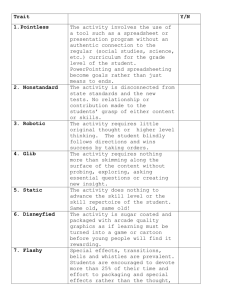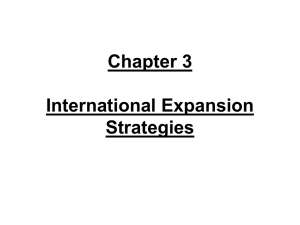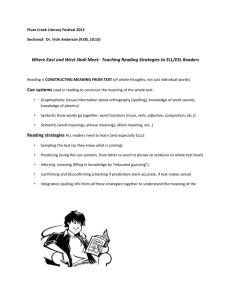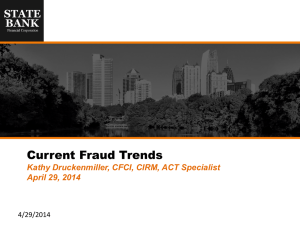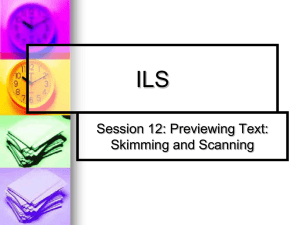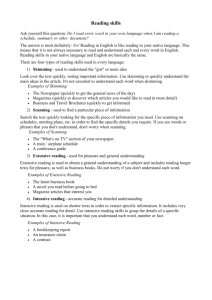Chapter 2 – Skimming
advertisement
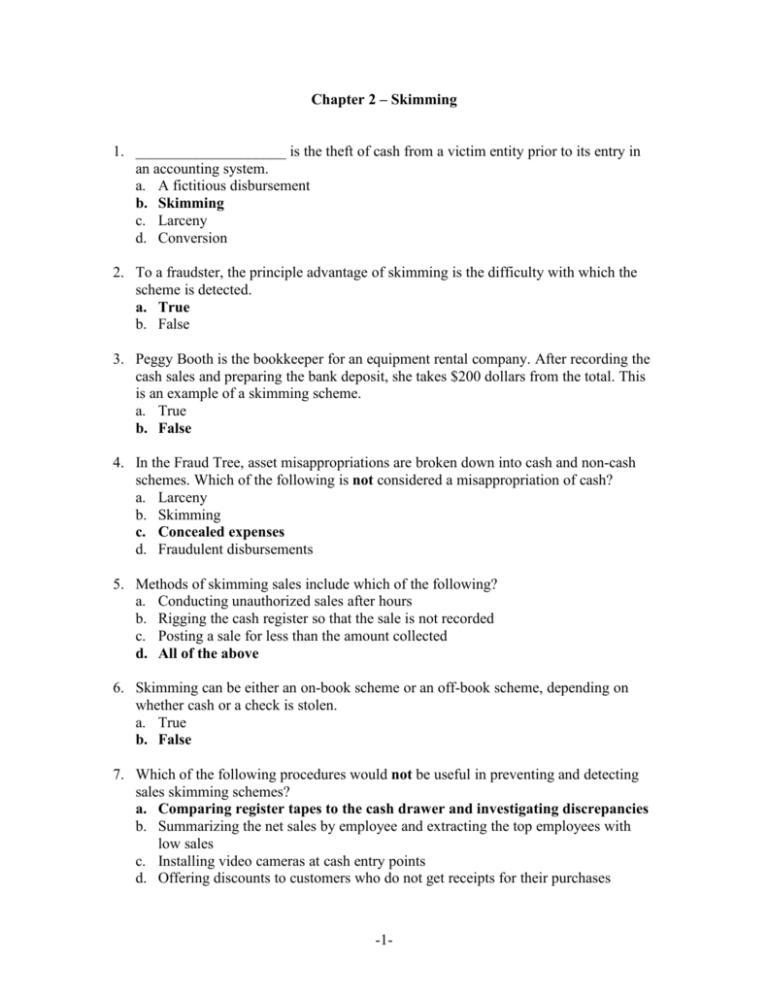
Chapter 2 – Skimming 1. ____________________ is the theft of cash from a victim entity prior to its entry in an accounting system. a. A fictitious disbursement b. Skimming c. Larceny d. Conversion 2. To a fraudster, the principle advantage of skimming is the difficulty with which the scheme is detected. a. True b. False 3. Peggy Booth is the bookkeeper for an equipment rental company. After recording the cash sales and preparing the bank deposit, she takes $200 dollars from the total. This is an example of a skimming scheme. a. True b. False 4. In the Fraud Tree, asset misappropriations are broken down into cash and non-cash schemes. Which of the following is not considered a misappropriation of cash? a. Larceny b. Skimming c. Concealed expenses d. Fraudulent disbursements 5. Methods of skimming sales include which of the following? a. Conducting unauthorized sales after hours b. Rigging the cash register so that the sale is not recorded c. Posting a sale for less than the amount collected d. All of the above 6. Skimming can be either an on-book scheme or an off-book scheme, depending on whether cash or a check is stolen. a. True b. False 7. Which of the following procedures would not be useful in preventing and detecting sales skimming schemes? a. Comparing register tapes to the cash drawer and investigating discrepancies b. Summarizing the net sales by employee and extracting the top employees with low sales c. Installing video cameras at cash entry points d. Offering discounts to customers who do not get receipts for their purchases -1- 8. To cover up a skimming scheme in which the employee takes cash from the register, the employee must make a voided sale in order for the register to balance. a. True b. False 9. Which of the following techniques is not used to conceal sales skimming schemes? a. Lapping b. Inventory padding c. Destroying records of transaction d. Recording false voids 10. The customer service department at JNC, Inc. has been receiving phone calls from customers for whom there is no record. This is a red flag of what type of scheme? a. Receivables skimming b. Shell company c. Unrecorded sales d. None of the above 11. Skimming receivables is generally more difficult to conceal than skimming sales. a. True b. False 12. The concealment of receivables skimming can be difficult because: a. The audit trail must be destroyed. b. The incoming payments are expected. c. Inventory must be padded to conceal shrinkage. d. All of the above 13. Receivables skimming can be concealed through: a. Lapping b. Force balancing c. Document destruction d. All of the above 14. A method of concealing receivables skimming by crediting one account while abstracting money from a different account is known as: a. Account substitution b. Kiting c. Lapping d. Plugging 15. Procedures that can be used to prevent and/or detect receivables skimming include which of the following? a. Reconciling the bank statement regularly b. Mandating that employees take annual vacations c. Performing a trend analysis on the aging of customer accounts d. All of the above -2- 16. Mandating supervisory approval for write-offs or discounts can help prevent receivables skimming schemes. a. True b. False 17. Which of the following computer audit tests can be used to detect skimming schemes? a. Summarizing by employee the difference between the cash receipt report and the sales register system b. Identifying unique journal entries to the cash account c. Joining the customer statement report file to the accounts receivable and reviewing for balance differences d. Extracting invoices paid by cash 18. Computing the percentage of assigned time to unassigned time for employees is one method to detect an employee skimming scheme. a. True b. False 19. Asset misappropriations are broken down into two categories: cash schemes and noncash schemes. According to the 2010 Report to the Nations on Occupational Fraud and Abuse, cash schemes are much more common than non-cash schemes. a. True b. False 20. According to the 2010 Report to the Nations on Occupational Fraud and Abuse, skimming schemes are both the most common and the most costly type of cash misappropriation scheme. a. True b. False 21. George Albert was a property manager for a large apartment complex while he was going to college. One of his duties was to collect rent from the tenants. If rent was paid after the third of the month, a late fee was tacked on to the amount due. When a tenant paid his rent late, George would backdate the payment, record and remit only the rent portion to his employers, and pocket the late fee. This is an example of what type of fraud? a. Larceny b. Sales skimming c. Fraudulent write-offs d. Plugging 22. Anne Mullens is the bookkeeper for DWG Refrigeration Repair. One afternoon while she was preparing the bank deposit, a customer came in to the office and paid his account in full with a $57 check. Rather than adding the check to the deposit, Anne pocketed $57 cash from the previously recorded amount and included the customer’s check in the money to be taken to the bank. What type of scheme did Anne commit? a. Larceny b. Kiting -3- c. Skimming d. Currency balancing 23. Sue Meyers was an accounts receivable clerk for an insurance broker. When premium payments were received, she would steal the check of every tenth customer and cash it at a liquor store. To conceal her scheme, she would credit the account of the customer that she stole from with a payment that was received from another customer’s account. This is an example of: a. Force balancing b. Lapping c. Understating sales d. A forged endorsement scheme 24. Jason Herman works part-time as a retail clerk at a local bookstore. One night while his manager was out of town, Jason decided to keep the store open for a few extra hours. He reset the cash registers at the normal closing time, but continued making sales. Two hours later, when he closed for the night, he reset the registers again, removing all evidence that any extra transactions had been made, and pocketed the money from the after-hours sales. What kind of scheme did Jason commit? a. Register disbursement b. Force balancing c. Receivables skimming d. Unrecorded sales 25. Myra Manning, CFE, was hired to investigate some suspicious activity at Arizona Medical Supply after one of the company’s largest customers complained several times that its account statements do not reflect all the payments it has made. While examining the accounts receivable activity, Myra noticed a significant rise in the volume of overdue accounts during the last 6 months. What type of scheme might this situation indicate? a. Cash larceny b. Shell company c. Receivables skimming d. False refunds 26. In one of the case studies in the textbook, Brian Lee, a top-notch plastic surgeon, collected payments from his patients without giving a cut to the clinic where he practiced. How was his fraud discovered? a. Through a routine audit of the clinic’s records b. Through an anonymous tip to the clinic c. By accident d. None of the above 27. In one of the case studies in the textbook, Brian Lee, a top-notch plastic surgeon, collected payments from his patients without giving a cut to the clinic where he practiced. What was his motivation for committing the fraud? a. He needed to repay his student loan. b. He was greedy. -4- c. He felt that the clinic was taking too much of a cut from his income. d. He wanted to use the proceeds to fund his “doctors without borders” practice. 28. In one of the case studies in the textbook, Brian Lee, a top-notch plastic surgeon, collected payments from his patients without giving a cut to the clinic where he practiced. How was he punished? a. He was convicted of grand larceny and sentenced to probation. b. He was sued in civil court for the amount of the loss. c. He was terminated from the practice and was required to make full restitution in lieu of prosecution. d. He was allowed to continue to practice at the clinic but was required to make full restitution. 29. In one of the case studies in the textbook, Stefan Winkler was the controller for a beverage company in south Florida. Money was collected by either the delivery drivers who brought in the cash and checks from their route customers (route deposits), or by credit customers who mailed in their payments (office deposits). Winkler stole cash from the route deposits and made up for it by using checks from the office deposits. How did Winkler conceal his crime? a. He altered electronic files b. He stole cash receipt journals, copies of customer checks, and deposit slips c. He removed his personnel file d. All of the above 30. In one of the case studies in the textbook, Stefan Winkler was the controller for a beverage company in south Florida. Money was collected by either the delivery drivers who brought in the cash and checks from their route customers (route deposits), or by credit customers who mailed in their payments (office deposits). Winkler stole cash from the route deposits and made up for it by using checks from the office deposits. Which of the following red flags were present that could have alerted the company to the fraud? a. Missing deposit slips b. Customer complaints c. Winkler never took vacations d. All of the above -5-


